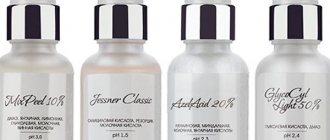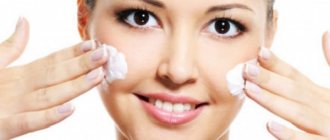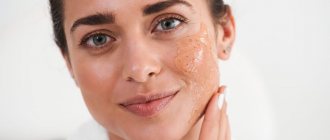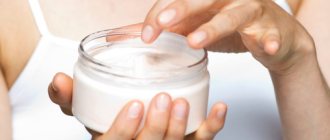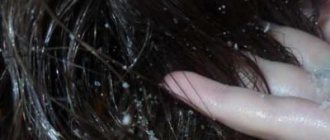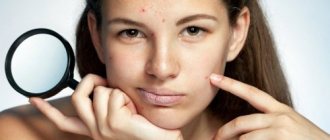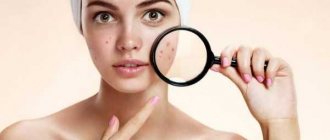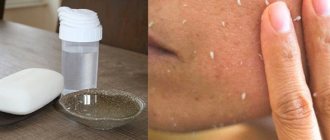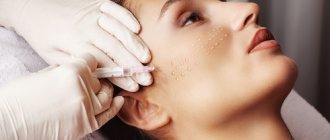In matters of deep cleansing of the skin and exfoliation of dead cells and keratinized layers, acids play a leading role. Azelaine peeling is one of the favorite options for chemical cleansing, which can not only correct age-related skin imperfections, but also cope with rosacea, rosacea, and acne on the face. Cosmetologists recommend using products with azelaic acid for patients with problematic and sensitive skin for therapeutic and preventive purposes. Let’s look further at the benefits and features of the azelaine procedure.
Benefits of azelaic acid for skin
Azelaic acid is a faithful assistant and doctor for problematic and oily skin prone to acne and acne. The chemical compound is also called nonanedioic acid and belongs to the category of carboxylic acids. The active component is obtained biochemically, by oxidation of linoleic and oleic acid.
Despite the chemical nature of its appearance, azelaic acid has medicinal and beneficial properties, is widely used in the production of medicinal creams, gels, and is also very popular in cosmetology for cleansing and healing the skin.
The benefits of azelaic acid and its difference from other chemical cleansers are as follows:
- relieves inflammation (after the procedure, painful redness goes away faster, reducing the risk of their occurrence in the future);
- has an antibacterial effect, especially against Staphylococcus epidermidis and Propionibacterium acnes;
- deeply cleanses pores, preventing the appearance of comedones, blackheads, and sebaceous plugs;
- normalizes the secretion of the sebaceous glands;
- actively fights folliculitis, post-acne, age spots, evens out and whitens the complexion;
- neutralizes toxins thanks to its high antioxidant properties;
- acts as an excellent antiseptic (relevant for acne, acne);
- improves tissue regeneration, renewal, increases skin turgor and tone.
Attention! Azelaic acid is not used on its own. Additionally, the peeling composition includes mandelic, lactic, salicylic or glycolic acids. The complex effect of chemical compounds provides a more pronounced and lasting effect.
The azelaic substance is present in small amounts in skin cells, so acid cleansing rarely causes complications.
For the preparation of cosmetics, nonandioic acid is used in a concentration of 1–20%. For peeling, cosmetologists use solutions with a higher content of chemical compounds (up to 30%). In this case, burning and tingling may occur, accompanied by slight redness.
Description of the technique
Azelain facial peeling is a procedure during which the chemical action of acid is carried out on the outer layer of the epidermis.
As a result, intensive exfoliation of keratinized particles occurs - blackheads are eliminated, small wrinkles are smoothed out, and pigment spots are lightened.
Buyanov Sergey Yurievich (Expert Doctor):
Azelaic acid has long been used in dermatology as a remedy for acne.
Despite the nature of origin, the active component does not harm the body and has a keratolytic, anti-inflammatory effect. Moreover, the environment created by the reagent is extremely destructive for many pathogenic bacteria.
Efficiency
- The acid included in the composition has bacteriostatic activity, so it helps eliminate acne, comedones, and rosacea without leaving a trace.
- The processes of keratinocyte production and compaction of the surface layer are inhibited.
- Prevents clogged pores and the appearance of blackheads.
- There is a gentle lightening of the shades of the skin (the active substance stops the synthesis of melanin, therefore it affects pigmentation, regardless of its etiology).
Advantages of the procedure: in the future, epidermal cells do not develop resistance to the main component of the drugs, which allows correction to be repeated more than once.
In most cases, peeling is carried out as a preparatory stage (before deeper cleansing) or is used for skin with moderate defects.
The effect of chemical exposure can be enhanced by subsequent dermabrasion or laser resurfacing.
The essence of the procedure
Products with azelaic acid affect the skin simultaneously in several directions:
- Deeply and gently cleanses. Penetrating deep into the epidermis, acid molecules dissolve the bonds between dead cells, stimulating their easy and rapid removal.
- Whitens skin. Azelain particles block the activity of melanocytes, which provoke melasma and other types of pathological hyperpigmentation. This helps even out the tone and prevent the appearance of age spots.
- Completely eliminates acne, rosacea, and other dermatological problems. Nonandioic acid has high bacteriostatic activity. It will be destructive for Propionibacterium acnes, Staphylococcus epidermidis. Regular use of the product helps reduce the number of problematic elements and reduce the risk of their occurrence after therapy.
- Refreshes, eliminates greasy shine. Acid particles stabilize the work and secretion of the sebaceous glands, help to establish self-cleaning of the mouths of the glands, prevent clogging of pores and the appearance of comedones.
- Restores the “breathing” of the skin, improves tone and elasticity of fibers, smoothes wrinkles and slows down the aging process. After azelaine peeling, the skin is more sensitive to active serums and nourishing creams. They quickly absorb beneficial components, thereby increasing the effectiveness of cosmetic products and improving the quality of the skin.
Cosmetologists recommend using azelaine peeling for rejuvenation only in combination with other cosmetic procedures. One cleansing can only give a superficial and short-lived effect of youth, freshness, nothing more. You can reinforce and enhance the achieved result with microdermabrasion, laser resurfacing, and deep acid peeling.
It is recommended that the procedure be performed by a highly qualified cosmetologist, although peeling at home is also possible. But keep in mind that home cleansing cannot guarantee the declared effect, plus it increases the risk of developing side effects and complications.
You can purchase an exfoliant in an online store, from your cosmetologist or in professional cosmetics stores. Don’t forget to pay attention to whether the seller has the appropriate documentation confirming the quality and originality of the product, and to make sure that the packaging is intact and that the expiration date has not expired.
Some girls take a big risk when purchasing concentrated azelaic acid at the pharmacy. Incorrect dilution proportions lead to burns, prolonged redness, and dry skin.
Note! Ready-made cosmetic products for peeling have a balanced composition and are supplemented with emollient additives, so the process of acid exposure is easier to control. But they are more difficult to buy (many manufacturers work only with cosmetologists), and the cost will be rather high.
Preparation for azelaine peeling
It is very important to prepare your facial skin for this procedure. First, choose a salon and a specialist
Make an appointment with a dermatologist or cosmetologist, let him examine you, help identify the cause of skin diseases and defects, perhaps you need to treat the problem not only externally, but internally. Be sure to tell your cosmetologist who will perform the procedure if you are allergic to anything, especially if you are allergic to medications; it is also worth telling about the medications that you are currently taking or have taken recently.
Next, the cosmetologist gives you recommendations on how best to prepare your skin for peeling, and what skin care products you need
will be required. If for some reason you cannot prepare your skin for peeling according to all the recommendations, then be sure to tell us so that the cosmetologist can use a lower concentration of the substance and reduce the exposure time.
However, we do not recommend ignoring preparation, as this may not give the desired results or result in unpleasant consequences. If you follow the procedure according to all the rules, then you will spend 7-10 days cleansing the skin and applying a special care cream that will help adapt the epidermis to the effects of azelaic acid.
Two to three days before the appointed day, you need to do a test for an allergic reaction. Simply apply a small amount of azelaic acid to the delicate skin in the elbow area. It is better to do this test in the office of a cosmetologist or dermatologist, so that in case of severe allergies you can be provided with help. If there is no negative reaction, then after a couple of days you go for the procedure.
Stages of azelaine peeling
- Like all other cosmetic procedures, peeling begins with thoroughly cleansing the skin of dirt and decorative cosmetics.
- Then the epidermis is degreased using a glycolic acid-based product.
- The face is ready, now the master must take care of protecting particularly sensitive areas of the skin, such as the area around the eyes and lips. In this case, a silicone-based protective agent is applied to delicate areas of the skin.
- That's it, the preparatory stage has been completed, now the cosmetologist applies the main substance to the skin. The most commonly used azelaine peeling is Mediderma and Simildiet Laboratorios Spain. The main product is applied to the face with massage movements and rubbed in for 7-10 minutes, the time can be reduced or increased, depending on the condition of the client’s skin.
- After which the product is removed, the face is slightly dried with a napkin or paper towel. And then a sedative is applied. It should be left for 4-6 hours.
If you are prescribed a course of azelaine peeling, then the next procedure can be performed no earlier than two weeks later. The break between courses of procedures should be 6-8 months.
Indications for use
Cosmetologists prefer to prescribe azelaine peeling to clients with dermatological problems and oily skin types, although the procedure has no restrictions on the type of skin. In most cases, indications for acid exposure are:
- acne in adults, adolescents;
- rosacea, demodicosis;
- folliculitis and manifestations of ingrown hairs in the skin;
- acne, seborrhea and dermatitis of any degree;
- rosacea (vascular spider veins on the face);
- comedones, blackheads;
- excessive production of sebaceous secretions;
- pathological hyperpigmentation, melasma;
- signs of photoaging, including those caused by prolonged exposure to the sun;
- expression lines, age wrinkles;
- dullness, grayness of complexion.
Azelaine peeling is often used to prepare for complex cosmetic procedures for skin rejuvenation (microcrystalline dermabrasion, laser treatment).
The procedure has no age restrictions. Peeling will be useful in adolescence or adulthood, if there are appropriate indications.
Peeling effectiveness
Expecting an instant transformation and cure of problems on the face, many patients are very disappointed after the peeling. One procedure is not enough to solve the problems; course therapy is required.
The number of peelings is determined only by a cosmetologist after a detailed analysis of the condition of the skin. As a rule, these are 5–12 procedures, once every 1–1.5 weeks.
The effect of therapy lasts for about 6 months, after which the course is repeated. A significant advantage of azelaic acid is that it is not addictive, so it is suitable for long-term use.
After a course of acid exposure, you can expect the following changes:
- the greasy shine of the integument is replaced by a healthy glow;
- skin tone is evened out;
- the number of problematic, inflamed elements is significantly reduced;
- the face becomes clean, without blackheads;
- the skin becomes more elastic, elastic, tone and turgor increase;
- the face looks fresher, younger.
Ready-made drugs
Choosing a peeling product is the first step on the path to perfect, healthy skin. For the average user, it can become an insurmountable barrier, thanks to the diversity and richness of the range of drugs with azelaic acid. In this case, it is better to trust the experience and opinion of your cosmetologist. Let us note several products that cosmetologists trust and use in their work.
MediDerma
MediDerma is a well-known Spanish brand of professional cosmetics, loved by cosmetologists for its high quality products and loyal pricing policy. The company offers a whole line of products for azelaine peeling. With their help, you can get rid of melasma, hyperpigmentation, acne, stagnant post-acne spots and a number of dermatological diseases, smooth out fine wrinkles, even out skin color and normalize the functioning of the sebaceous glands.
Important point! Mediderm peels can be used individually, but to quickly solve the problem, you should adhere to a complex effect.
They differ in composition and acidity. All products are universal, suitable for any skin type and age. Designed for salon procedures. The depth of impact is also controlled by the number of layers applied.
Azelak M. Peeling contains azelaic (15%), salicylic (18%) and mandelic (10%) acids, camellia extract. pH level 1.0. Used for face, neck. Mediderma peeling costs about 7,350 rubles per 60 ml.
Azelac RU . The peeling product contains, in addition to azelaic acid (20%), mandelic (10%), phytic (5%) and ferulic acids (2%), 4N-butylresorcinol (5%). pH level 1.0. Area of application: face, neck. The price of a package (60 ml) is 7800 rubles.
Azelac exfoliating gel . The active components of the peeling are azelaic acid (20%) and lactic acid (3.5%), thistle extract (2%). pH level 2.5. Area of application: face, neck. The cost of a 100 ml package is 10,890 rubles.
GIGI
Bioplasma Azelaic Peel from GiGi (Israel) is a gel-based azelaic peeling. The product contains a complex of acids (azelaic, malic, glycolic, tartaric, citric), extracts of algae, plankton, and olive oil. The cosmetic product is suitable for all skin types, provides deep and delicate cleansing, heals and rejuvenates the skin.
Peeling gel is applied to cleansed skin in a thick layer for 5–10 minutes and accompanied by a light massage. The exposure time depends on the degree of sensitivity of the skin and is adjusted individually.
The total cost of the product is 7680 rubles, volume 200 ml.
Simildiet
According to the manufacturer, Simildiet professional cosmetics (Spain) do not cause side effects and have no contraindications. In other words, absolutely universal.
Azelaic facial peeling Peeling Azelaico has a gel texture and contains azelaic (20%), salicylic (2%) and lactic (3%) acids, arnica extract (5%). pH level 3.14.
The product delicately removes dead skin layers and ensures deep penetration of nutritional components into the deep layers of the skin. Indicated for folliculitis, rosacea, hyperkeratosis, oily seborrhea, acne, comedones. Recommended for those with oily and problematic skin.
Performed in courses of 5–7 procedures with an interval of 10–15 days. Apply the product to cleansed and prepared skin. The exposure time is determined individually (before the appearance of hyperemia). Then the composition is neutralized, and a peeling treatment is applied to the face.
Cost - 6200 rubles, volume 60 ml.
Expert opinion
- Cosmetologist
- Surgeon
Michelle Ellern
practicing cosmetologist-dermatologist
I perform azelaine peeling more often as a preparatory stage for a deeper cleansing of the epidermis. As an independent procedure, it gives a good preventive effect only on clean, healthy skin. If there are cosmetic problems, then I carry it out only in combination with other types of cleaning.
Theda Contis
plastic surgeon
You need to understand that any chemical peeling is a reaction between skin cells and a solution, which results in the destruction of the surface layer of the epidermis and cellular renewal.
It is important to choose the chemical composition in accordance with your skin type so that it copes with the assigned tasks. Azelaine peeling is one of the few compositions that is suitable for all types of epidermis. It gently exfoliates the stratum corneum and almost never causes side effects. Azelin peeling is popular among cosmetologists. With its help, you can thoroughly cleanse the skin and prepare it for more serious procedures.
This procedure helps eliminate problems such as pigmentation, acne, etc. And for this you don’t have to go to a cosmetologist, since there are products for sale for home use.
Preparing the skin for the procedure correctly
To prevent acid exposure from resulting in complications and a long rehabilitation period, it is important to properly prepare the skin for the procedure. What is meant?
- Choose a first-class clinic, beauty salon. Your health, the outcome of the cosmetic procedure and the speed of skin restoration largely depend on the professionalism of the cosmetologist.
- Visit a cosmetologist. A detailed study of the problem and the characteristics of the skin will allow you to choose the optimal type of cleansing, peeling agent, frequency and amount of exposure required.
- Even if you decide to do peeling yourself at home, a visit to a cosmetologist is mandatory.
- Identify contraindications and conduct an allergy test to rule out irritation, allergic rash and other complications after peeling.
- Take care of skin hydration. Use creams with a small content of fruit acids 2 weeks before peeling. This will soften the upper layer of the epidermis, ensuring a deeper and more uniform effect of the azelaine product.
- 2-3 days before cleansing, check how the skin reacts to azelaic acid.
- There is no need to plan or fine-tune therapy until early spring or late autumn. Nonandium peeling can be performed even in summer.
Important point! It happens that for some reason the client was unable to properly prepare the skin for the procedure. In this case, the acidic agent is kept for a minimum time; in subsequent sessions, the duration of exposition is increased.
Question answer
The procedure is contraindicated in case of hypersensitivity to azelaic acid, violation of the integrity of the skin (for example, scratches), infectious processes on the skin (herpes, ulcers, etc.), pregnancy and breastfeeding.
Peeling is recommended to be carried out in winter, late autumn, early spring. During these times of the year, the lowest level of UV radiation is observed, so the likelihood of pigmentation as a complication is minimized. If peeling is carried out in the summer, then you must use SPF cream with a protection level of at least 50.
The procedure is carried out in a course. You may need from 3 to 8, depending on the complexity of the problem and the desired result. The interval between procedures is 1-2 weeks.
Protocol
Exposure to the nonandium composition is carried out in a strictly specified sequence. Deviation from the instructions may result in burns or poor results. Please ensure that the cosmetologist prints out the product in front of you and enters its data into the patient’s record. It would be useful to verify the suitability of the drug and the availability of a certificate.
The algorithm for performing acid exposure is as follows:
- Remnants of makeup are removed from the face. A soft cleanser (foam, milk, lotion) with glycolic acid 3% helps the cosmetologist remove particles of sweat and properly prepare the skin for exfoliation.
- To protect sensitive areas (near the eyes, surface of the lips and corners of the mouth) from the aggressive effects of acid, cream is applied to them. Its composition necessarily contains silicone derivatives and other chemical components that block acidic effects.
- If necessary, the cosmetologist prepares the peeling product by mixing it with an antiseptic liquid in the proportion recommended by the manufacturer. The acid concentration is 15–30%.
- The prepared composition is distributed evenly over the surface of the face using a brush or pipette and rubbed into the skin with light massage movements. At this moment, the patient may feel a slight tingling, slight burning sensation. The massage should be stopped when the fingers stop sliding over the skin. The exposure time depends on several factors: the concentration of the product, its acidity, skin characteristics and the wishes of the client.
- Some manufacturing companies recommend applying several layers of exfoliant to ensure a deeper effect. In this case, the first layer of the product is applied, left for 1-2 minutes, then the next one is applied.
- To neutralize and remove exfoliant residues, the cosmetologist uses distilled water or a neutralizer offered by the manufacturer of the peeling product used.
- Your face may turn slightly red during cleansing. Special masks and serums will help soothe the skin, saturate it with important microelements, vitamins, nutritional supplements for quick recovery and prevent the appearance of spider veins on the face. The bioconcentrate is applied to the patient’s skin and is not washed off for 6 hours.
The entire cleansing process with azelaic acid takes 20–30 minutes. At the end of the peeling, the cosmetologist discusses possible side effects and rules for skin care during the post-peeling period, and sets a date for the next appointment. The patient recovers home.
Instructions for use (5 steps)
Peeling is carried out in the following sequence:
- Before peeling, you must thoroughly cleanse your face of dirt, makeup, and degrease the epidermis.
- Apply 1 thin layer of product to skin. Distribute using rubbing movements until your fingers stop slipping.
- Azelaic acid should not be allowed to come into contact with the mucous membranes of the mouth, nose, or eyes. Wait until completely dry and apply the 2nd layer.
- If necessary, the composition can be distributed pointwise, only on problem areas. The duration of the procedure is 15 minutes. If your skin is sensitive, areas with white spots may appear. This effect can be neutralized by immediately rinsing with cold water.
- After cleansing the skin of the composition, dry it with a towel and apply moisturizing, softening, sunscreen cosmetics (creams, lotions).
Healing period
After superficial peeling with nonandioic acid, patients' faces appear pinkish, without pronounced traces of acid exposure. Restoration of the skin after exposure to acid takes up to 2 weeks. At this time it is recommended:
- provide sufficient hydration to the skin, use softening and nourishing products of light texture (fluids);
- refuse cosmetics with abrasive and aggressive chemical particles;
- constantly protect weakened skin from sun exposure, choose sunscreens and lotions with SPF 30 and higher;
- if necessary and on the recommendation of a specialist, use regenerating ointments, gels (Bepanten, D-panthenol);
- to prevent herpes rashes, the patient is prescribed antiviral drugs;
- do not visit baths, saunas, swimming pools, postpone active sports;
- avoid direct sunlight on the face;
- Until complete recovery, forget about tanning and going to the solarium;
- The cosmetologist provides additional recommendations and referrals for restorative procedures on an individual basis, in the presence of side effects and complications.
Attention! Cosmetologists strongly recommend using post-peeling products of the same brand as the peeling. This will provide complete skin care and speed up healing.
Complications likely after receiving azelaine peeling procedures
Like most types of superficial and medium peeling, azelaine cleansing is associated with possible complications, but with a highly qualified cosmetologist, all of them are eliminated during a properly organized rehabilitation period.
Complications that characterize azelaine peeling are divided into immediate, occurring during the regeneration stage (2-4 weeks after completing the course) and persistent (from 4-10 weeks of the recovery period).
Possible immediate complications include:
1. Skin dehydration, i.e. its overdrying. Eliminated by applying a soothing gel, masks with added collagen and consolidating the effect with a mask of fatty cream with extracts of aloe, tea tree, and chamomile.
2. Swelling of the facial skin. It is removed with mild moisturizers (liquids or gels with the addition of antioxidant substances), restoring the normal epidermal barrier.
3. Exacerbation of herpes infection, which can lead to scarring. The problem is eliminated by starting a course of classical antiherpetic therapy with the drugs Acyclovir and Valtrex (ointments and tablets), used according to the instructions.
4. Skin infection. Occurs due to violation of asepsis rules during post-peeling care. It is quickly removed by standard antibiotics: Oxycort, Kefzol, Baneocin.
5. Allergies. Occurs if blood tests for azelaic acid tolerance are neglected before starting the course.
Complications that arise during the regenerative period:
1. Erythema. It is treated by stopping visiting saunas, swimming pools and solariums in combination with taking special medications - Omega-3 fatty acids, Hepatrombin, creams with arnica extract. Sometimes it requires photocoagulation or microcurrent therapy to restore blood circulation in skin cells.
2. Hyperpigmentation. For prevention, it is recommended not to neglect thorough pre-peeling preparation for 1-1.5 months before starting the course and under no circumstances be in direct sunlight without applying sunscreen fluids to the face. In the post-peeling weeks, it is advisable to take anti-inflammatory drugs containing natural antioxidants. If hyperpigmentation has already appeared, you can get rid of it with the help of whitening products.
3. Seborrhea and exacerbation of acne. Typical for patients who have received a peeling course for oily and dehydrated skin. Some cosmetologists recommend not to deal with these side effects in any way, since they go away on their own after 2-3 months of post-peeling care. Sometimes patients are prescribed Aevita and Tsintekral, anti-inflammatory gels are recommended - Zinerit, Skinoren, Curiosin, etc.
4. Skin hypersensitivity. It is observed in patients with slow rates of regeneration. Eliminated by long-term use of light creams with the addition of natural oils: shea butter, grape seed extract and evening primrose, hyaluronic acid, placenta extract and many others.
5. Enlarged pores. The side effect is not subject to cosmetic correction: it is enough to use pigment-constricting tonics without alcohol components.
Possible permanent changes that develop after the rehabilitation period:
1. Depigmentation. It can be eliminated with the help of decorative cosmetics, but imposes restrictions on permanent makeup.
2. Keloid scars. They are removed using cryotherapy, ozone therapy and a course of triaminolone injections. If there is an individual tendency to form scar tissue, prevention using silicone patches for external adhesive (Kontratubeks) is recommended.
Cost of the procedure in the salon
It is better to entrust any chemical peeling to professionals. Many years of experience in performing peelings, confident, quick and clear actions of the cosmetologist are the key points in achieving high results and problem-free recovery.
The price of peeling in different beauty salons, clinics, and medical centers can vary significantly. This is due to the brand and cost of the drugs and cosmetics used.
To a lesser extent, the price of the procedure is influenced by the rating and location of the clinic, the quality of the cosmetologist, and additional services. The estimated cost in Moscow is 2–3 thousand rubles per session.
Features of carrying out at home
Azelaine peeling at home can also be performed, the procedure is identical to the salon one. But you must consider the possible risks of complications. You also need:
- Before carrying out the procedure, seek advice from a cosmetologist; the presence of contraindications, even if the cleaning is performed correctly, can end sadly.
- Purchase a peeling product with a gentle composition, an acceptable pH level (above 3.0) and a low concentration of acidic components.
- Carefully study the instructions from the manufacturer and follow them unquestioningly.
- In case of severe discomfort or burning of the skin after applying the composition, without waiting for the specified exposure time, immediately neutralize it and rinse it off.
- Provide sterile conditions, act quickly, without fuss.
The effect of a home procedure in most cases differs from professional use and is less pronounced. The reason for this may be an incorrectly selected composition or exposure time of the drug. Therefore, the first peeling should be done only by a cosmetologist.
Execution Features
Technically, the procedure looks quite simple. Considering the safety of the active substance, azelaine peeling is allowed independently at home.
But it is very important to consistently carry out all the steps and not exceed the exposure time of the drugs.
And also be careful during the recovery period
Preparation
In principle, you can do without special preliminary preparation. But, if you want to increase the effectiveness of the procedure and shorten the duration of the course, it is better to treat your face daily with a gel or cream containing 5-10% lactic or glycolic acid a week before the first session. This will loosen the top layer of the epidermis and allow azelaic acid to penetrate deeper.
To prevent a severe allergic reaction, it is necessary to do an individual tolerance test.
Carrying out
Like any other peeling, azelaic peeling is performed in stages:
- Cleansing. Makeup is completely removed from the face, and any remaining creams and sebum are washed away.
- Degreasing. It is performed with an alcohol-containing tonic or “pre-peeling” - a substance with a small concentration of acids.
- Protection. Moles, the area around the eyes, and the delicate skin of the lips are covered with a layer of rich cream or Vaseline to avoid severe irritation by acid.
- Peeling. Quickly apply the peeling composition to dry, clean skin in an even, thin layer and leave for 2 to 10 minutes.
- Neutralization. A special neutralizer is applied to the face over the acid and left for no more than 2-3 minutes.
- Washing. The remaining product is thoroughly washed off with running moderately warm water.
- Recovery. Although the skin is not very irritated, it must be moisturized after peeling. A cream with aloe vera or hyaluronic acid is ideal for this.
If the procedure was done in a salon, then before going outside in the summer you must apply a cream with a UV filter, and in winter - a protective one. Large temperature changes and sharp winds can cause redness and quite severe irritation.
Rehabilitation
Soft peeling with azelaic acid for medicinal purposes can be performed even once every 5-7 days. This means that the skin recovers quickly after it. But the face must be protected primarily from mechanical injuries and negative environmental influences.
Here are the recommendations cosmetologists give:
- use only two-phase products or milk for makeup removal;
- do not abuse decorative cosmetics, especially long-lasting foundations;
- do not do facial massage or other types of peeling;
- Apply a moisturizing or skin softening cream twice a day;
- Try not to sweat or get too cold for two to three days after the procedure.
The ban on tanning, as well as visiting the sauna and solarium, is imposed for the entire course of procedures plus two weeks after its completion. The risk of pigmentation, although small, still remains. And if this condition is violated, it increases many times over.
Those who are accustomed to using masks prepared according to folk recipes or other home remedies should ensure that they do not contain substances that irritate the skin: alcohol, cinnamon, lemon juice, etc. You should not add essential oils. But milk and honey masks will be beneficial.
Precautionary measures
Despite the delicacy of the effect and therapeutic effect, the exfoliation procedure has a number of limitations.
Contraindications
The main contraindications include:
- pregnancy;
- breastfeeding (lactation period);
- allergy to the components of the drug;
- inflammation of the integument, except for cases specified by the indications for cleaning;
- herpes in the active stage;
- fresh tan;
- open wounds, abrasions, damage to the skin in the treatment area.
The relative restriction for performing the procedure is age under 18 years. If indicated, the doctor, after a detailed analysis of the problem, may prescribe peeling for medicinal purposes.
Exfoliation is performed all year round, but do not forget about protection from sunlight even in cloudy weather.
Side effects and complications
Side effects are unusual for azelaine peeling. Violation of the protocol for preparing and carrying out the procedure, neglect of contraindications can provoke the following unpleasant phenomena:
- feeling of tightness, excessive dryness of the skin;
- enlarged pores;
- tissue swelling in the affected area;
- infection of the integument, exacerbation of acne, seborrhea;
- exacerbation of herpes;
- allergic reaction to the drug (rash, irritation, itching);
- persistent erythema;
- hyperpigmentation;
- increased skin sensitivity;
- formation of keloid scars.
The appearance of one of these phenomena should alert you and become a reason to contact a specialist. Self-medication can be harmful and make the problem worse. Only a cosmetologist prescribes appropriate treatment and corrects skin care.
Benefits of Azelaine Cleanse
Treatment of the skin with azelaic acid is a gentle procedure; for extensive skin problems, it will not give a quick result, but its use causes mild irritation and causes the least injury. Azelaine peeling is easier to tolerate than others, and the recovery period can take only a few hours.
This acid is natural to the body, so procedures with it are generally well tolerated by the skin; the only disadvantages are direct contraindications. Cleansing is equally effective in young or mature people, in dark-skinned people with post-acne. The antibacterial effect does not contribute to the development of resistance in pathogenic microorganisms, therefore, with each procedure there will be a good result, which does not decrease even with repeated use.
Azelaine peeling does not increase sensitivity to sun rays, so it can be done all year round. It does not contribute to the occurrence of keratosis, that is, sebaceous plugs and comedones, which sets it apart from other exfoliation procedures.
Advantages and disadvantages
Despite the fact that exfoliation with azelaic acid is recommended for problematic and oily skin, those with normal and combination skin types are in a hurry to use it. All this thanks to an impressive list of advantages.
Advantages of the procedure:
- gentle and deep cleansing of the epidermis without peeling or usual post-peeling effects;
- has a therapeutic effect, is indicated for demodicosis, seborrhea, acne and other dermatological problems;
- acts in several directions simultaneously (cleanses, normalizes the secretion of sebaceous glands, evens out facial tone and skin texture, revitalizes);
- has a short rehabilitation period;
- side effects rarely occur;
- can be performed at any time of the year, even in summer;
- is not addictive;
- has a minimum of contraindications and restrictions;
- can be done at home;
- perfectly prepares the skin for complex cosmetic procedures (for example, diamond or laser resurfacing), increasing their effectiveness;
- acceptable price.
Surprisingly, the procedure has no disadvantages.
Opinion of cosmetologists
Professionals continue to recognize the effectiveness and gentleness of the effects of azelaic acid. Products from well-known manufacturers GIGI, MediDerma, Simildiet delight cosmetologists and patients with a high therapeutic effect and the absence of side effects.
There are a few more significant advantages of azelaine: it is easily neutralized with water and combines well with other cosmetic programs.
Cosmetologists recommend using azelaine peeling not only on the face, but also to treat inflamed areas and acne on the back.
User reviews
Finding patient reviews about the procedure is difficult. Not everyone decides to perform peeling for problem skin on their own, plus the cost of professional products is quite impressive. There are also no negative opinions about peeling with azelaic acid.
In conclusion, I would like to note that azelaine peeling is a simple and effective way to solve skin problems such as acne, folliculitis, acne, and rosacea. To guarantee success and cure the disease, it is important to choose an experienced cosmetologist and follow his recommendations. By performing azelaine peeling at home, you risk aggravating the situation.
Before and after photos
For comparison, photographs of problem skin are shown before chemical exposure to azelaine and after a course of 10 procedures.
